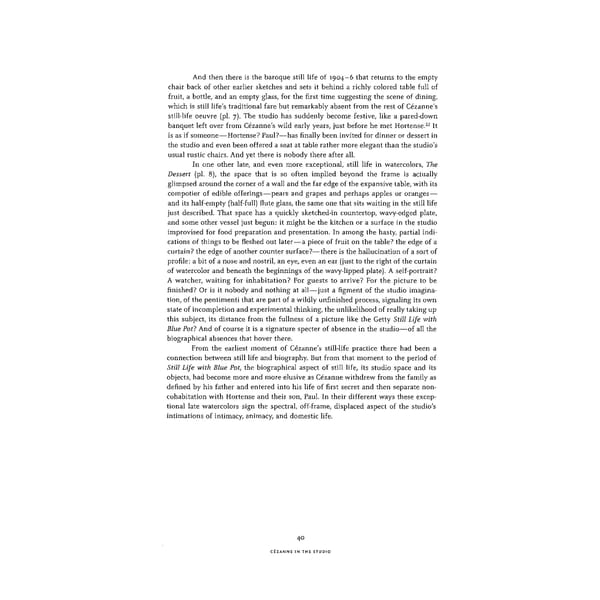And then there is the baroque still life of 1904-6 that returns to the empty chair back of other earlier sketches and sets it behind a richly colored table full of fruit, a bottle, and an empty glass, for the first time suggesting the scene of dining, which is still life's traditional fare but remarkably absent from the rest of Cezanne's still-life oeuvre (pi. 7). The studio has suddenly become festive, like a pared-down 22 banquet left over from Cezanne's wild early years, just before he met Hortense. It is as if someone—Hortense? Paul?—has finally been invited for dinner or dessert in the studio and even been offered a seat at table rather more elegant than the studio's usual rustic chairs. And yet there is nobody there after all. In one other late, and even more exceptional, still life in watercolors, The Dessert (pi. 8), the space that is so often implied beyond the frame is actually glimpsed around the corner of a wall and the far edge of the expansive table, with its compotier of edible offerings—pears and grapes and perhaps apples or oranges — and its half-empty (half-full) flute glass, the same one that sits waiting in the still life just described. That space has a quickly sketched-in countertop, wavy-edged plate, and some other vessel just begun: it might be the kitchen or a surface in the studio improvised for food preparation and presentation. In among the hasty, partial indi- cations of things to be fleshed out later—a piece of fruit on the table? the edge of a curtain? the edge of another counter surface?—there is the hallucination of a sort of profile: a bit of a nose and nostril, an eye, even an ear (just to the right of the curtain of watercolor and beneath the beginnings of the wavy-lipped plate). A self-portrait? A watcher, waiting for inhabitation? For guests to arrive? For the picture to be finished? Or is it nobody and nothing at all—just a figment of the studio imagina- tion, of the pentimenti that are part of a wildly unfinished process, signaling its own state of incompletion and experimental thinking, the unlikelihood of really taking up this subject, its distance from the fullness of a picture like the Getty Still Life with Blue Pot? And of course it is a signature specter of absence in the studio—of all the biographical absences that hover there. From the earliest moment of Cezanne's still-life practice there had been a connection between still life and biography. But from that moment to the period of Still Life with Blue Pot, the biographical aspect of still life, its studio space and its objects, had become more and more elusive as Cezanne withdrew from the family as defined by his father and entered into his life of first secret and then separate non- cohabitation with Hortense and their son, Paul. In their different ways these excep- tional late watercolors sign the spectral, off-frame, displaced aspect of the studio's intimations of intimacy, animacy, and domestic life. 40 CEZANNE IN THE STUDIO
 Cézanne in the Studio: Still Life in Watercolors Page 54 Page 56
Cézanne in the Studio: Still Life in Watercolors Page 54 Page 56